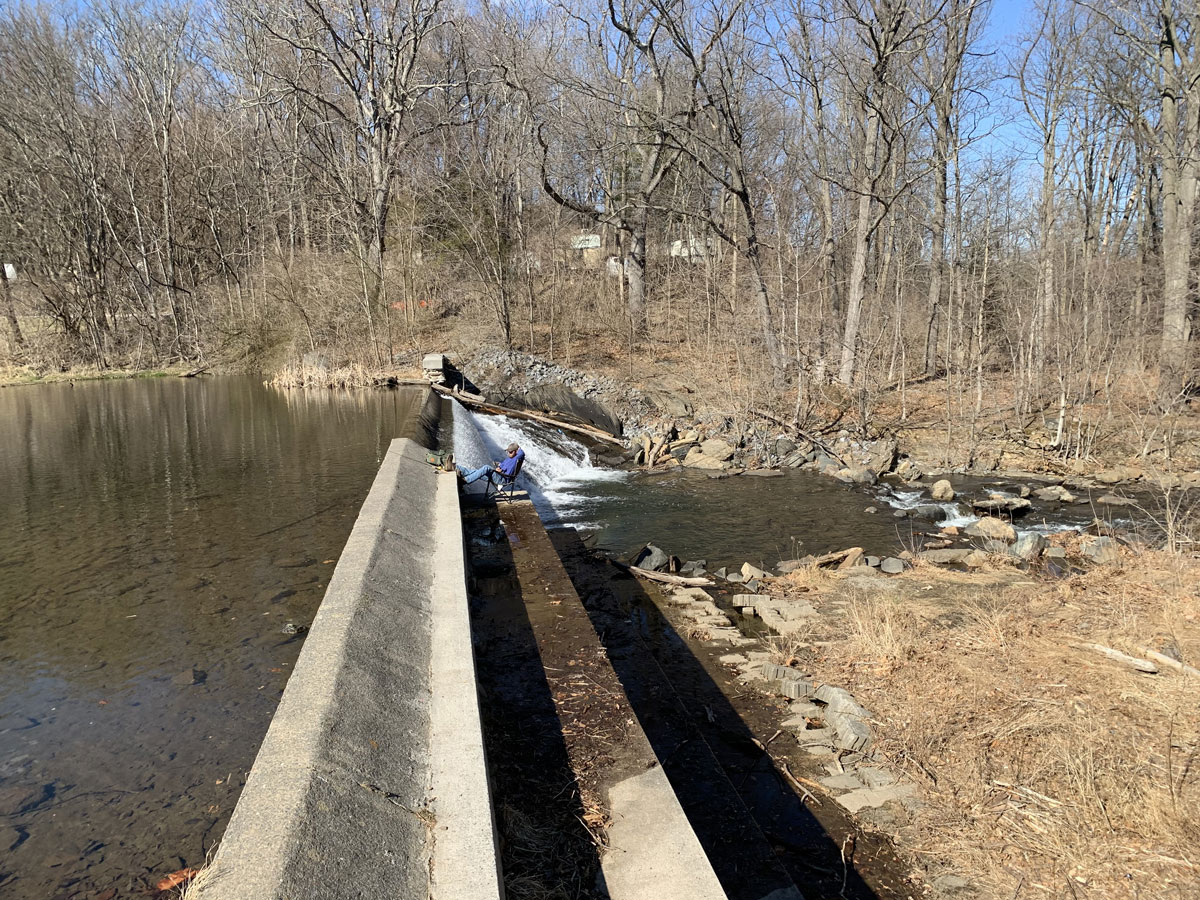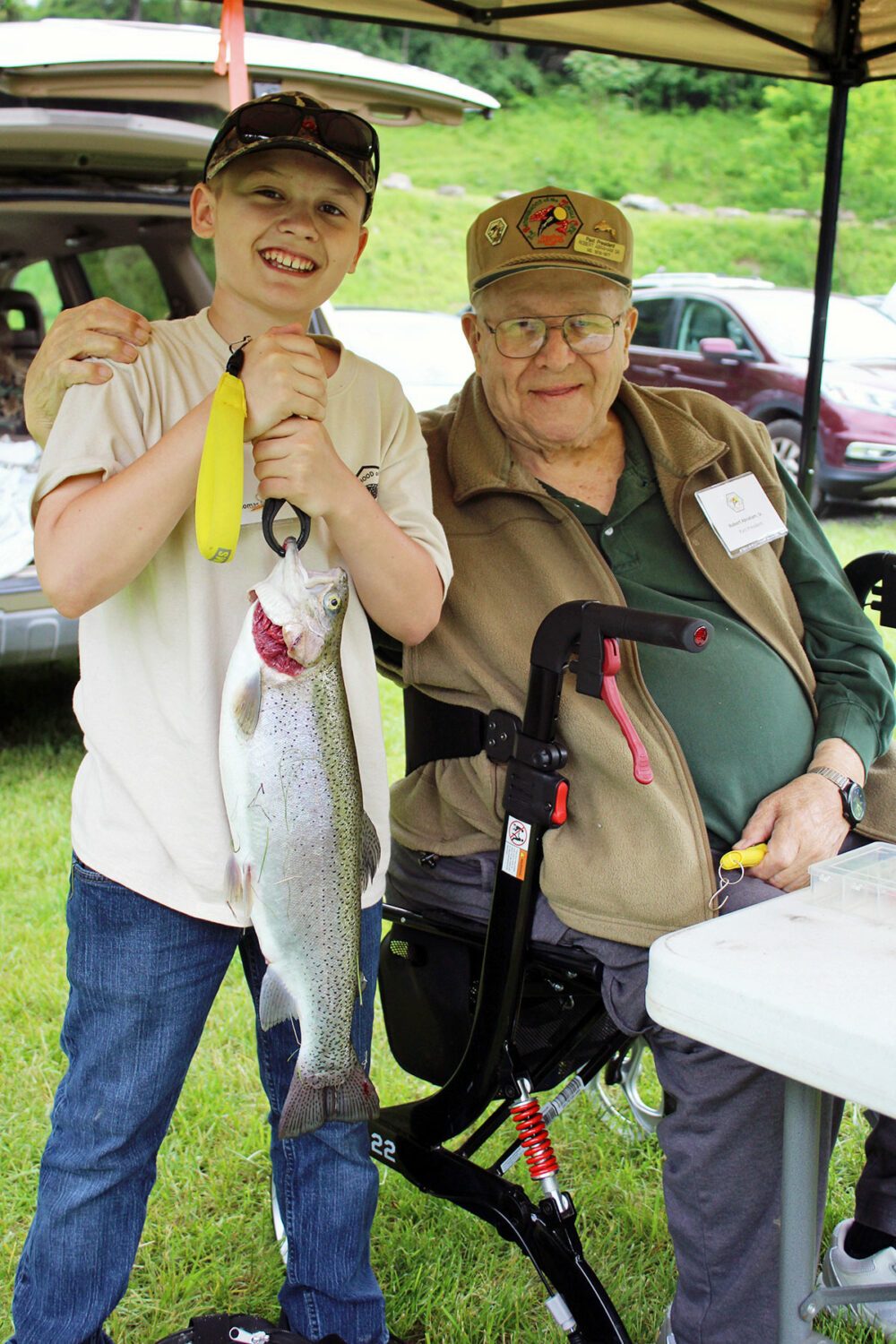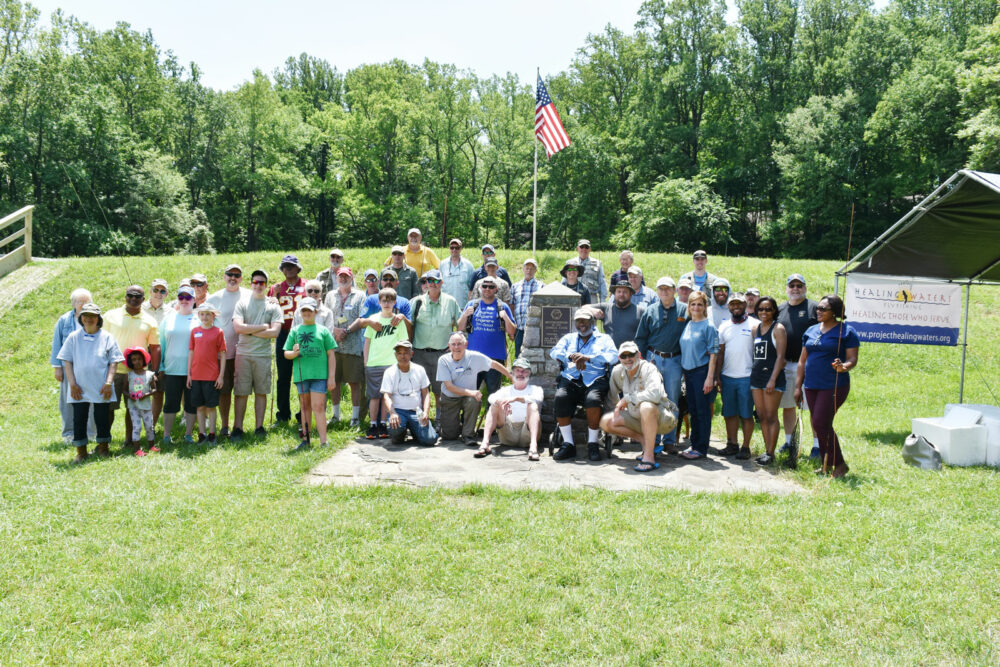Jim Kennedy
Trustee, Brotherhood of the Jungle Cock, Maryland Chapter
In the coming months and years, the gateway to the mountains – the term from which Thurmont derives its name – along Maryland Route 77 will be changing, even if ever so slightly, in response to two opportunities that have recently arisen. These opportunities are the planned removal of the dam that forms Frank Bentz Pond on the western edge of Thurmont; and a planned comprehensive review and update of the recreation trail network in Catoctin Mountain National Park.
The Brotherhood of the Jungle Cock (BOJC), an 80-year-old organization focused on teaching young people about conservation through the sport of fly fishing, was born along the banks of Big Hunting Creek in 1938. BOJC has a vision for shaping these changes in such a way as to expose young people to fishing and conservation while also linking downtown Thurmont to the state and federal parks that comprise the watershed of Big Hunting Creek. The public is now invited to give input.
Not only is Big Hunting Creek a waterway integral to Thurmont’s history and present recreational opportunities, but it is also a place central to the evolution of the modern sport of fly fishing and central to the catch-and-release ethic that is integral to all sport fishing.
Flash back to the earliest days of Thurmont in the late 1700s. The original name of the community was Mechanicstown, which reflected this place where the mechanized devices related to the production of iron were manufactured and maintained. The town’s industries were reliant on the production of charcoal in places like Foxville and other heavily-wooded communities. Charcoal produced in the woodlands was used to fire the iron furnace that is now showcased in the Catoctin Furnace area of Cunningham Falls State Park.
As the old-growth forests of the Catoctin Ridge were depleted, and in the aftermath of the War of 1812, ironworks in the United States were consolidated in the territories west of the Appalachian Front where both iron ore and coal were plentiful. Wheeling, West Virginia, and Pittsburgh, Pennsylvania, grew, as places like Mechanicstown declined.
In late 1893, after a community debate, the name Mechanicstown was changed to Thurmont, meaning, ‘gateway to the mountains.’
This was in keeping with the times as a shift took attention away from the exploitation of timber and ore to the use of the mountain vistas and recreational opportunities. That is to say, the vision of Thurmont shifted towards conservation as a means of increasing economic activity.
In recent months, the decisions to remove the dam and plan for a better trail system will allow Thurmont to continue this natural progression of capitalizing on the enjoyment of the natural world to spark economic activity.
Though coincidental, the geography of these projects has the potential to allow for a relatively simple development that could help turn Thurmont into more of a fly fishing destination than it already is and could reinforce the rich history of fly fishing started here. Big Hunting Creek and the Blue Ridge in Maryland and Virginia were the locations from which the modern sport of fly fishing evolved. The State of Maryland Fisheries and the BOJC were the fundamental in developing the catch and release sport and the culture of fly fishing. BOJC even has a fly fishing creed.
Whether an angler is fishing for sailfish off the coast of Central America, bonefish in the Indian Ocean, or trout in Big Hunting Creek, the sport’s heritage is rooted in the Catskill Mountains of New York State, the limestone basin of South Central Pennsylvania, and the Catoctin and Blue Ridge Mountains of Maryland and Virginia.
Without getting into the weeds of fly fishing history, it suffices to say Big Hunting Creek and the Blue Ridge streams of Virginia were good places to fish, and, owing to their proximity to Washington, D.C., regularly fished by U.S. presidents.
But, most significantly to the sport of fly fishing, Thurmont, the Federal park at Catoctin, and the BOJC share a common thread dating to the 1930s and the establishment of Catoctin Mountain National Park. The same people who established the BOJC were involved with planning for the national and state parks. Moreover, BOJC founders, most notably Joe Brooks, were responsible for the expansion of fly fishing beyond the pursuit of trout in mountain streams to gamefish in all environs.
Brooks and his friend Frank Bentz, Sr., were also responsible for establishing a means of passing conservation ethics on to new generations through the sport of fly fishing, through the BOJC. Though Brooks had no children, Bentz’s son, Frank Jr., was a BOJC member for the duration of his life. Frank III is an officer in the Brotherhood and Frank Sr.’s great-grandchildren are members, along with well in excess of 500 other active Brotherhood members across the U.S. in chapters in Pennsylvania, New York, Virginia, Ohio, and Michigan.
Though it was very much an honor for the pond to the west of Thurmont to be named in honor of Frank Bentz Sr., the fishing opportunity afforded at the pond is less than ideal. With the removal of the dam, however, there’s an opportunity to establish a youth-only, fly-fishing-only area. This would be an international first, which is only fitting. Big Hunting Creek itself, in the era of the establishment of Catoctin Mountain National Park, was among the first fly-only fish-for-fun (catch and release) streams in the country.
Prior to the 1930s, the sport of fishing presumed all fish, except those too small to eat, would be kept for eating. Beginning in the post-Civil War era of the late 1800s, population growth and the catch-and-keep ethic tended to result in the depletion of natural gamefish populations. A conservation movement arose. The movement achieved a high level of public attention under the presidency of Theodore Roosevelt.
With regard to fisheries management, there were differing schools of thought, with one component focusing on efforts to protect wild populations and another favoring supplemental stocking of hatchery-farmed fish. The latter won out and prevailed well into the 1900s and persisting today, but the latter did not vanish. Indeed, the protection and management of self-sustaining wild fisheries is an increasingly preferred option for fisheries managers and anglers alike.
When Catoctin Mountain National Park was in its formative stages as the Catoctin Recreational Demonstration Area in 1939, Big Hunting Creek was designated as a fly-fishing-only area. Fly fishing goes hand-in-hand with the catch-and-release ethic of wild fisheries management because fish that are hooked in the mouth will immediately spit an artificial fly if not hooked when they first strike. When bait is used, fish will generally swallow the morsel of bait containing a hook, typically resulting in fatal injuries. Thus, a fish caught on a fly can be released and reasonably expected to survive, grow, propagate the species, and even be caught again, providing multiple recreational opportunities. Modern research has established that fly-fishing catch-and-release is a solid management technique for maintaining a viable self-sustaining recreational fishery.
In the years prior to the 1939 establishment of the Catoctin Recreational Demonstration Area, the Commonwealth of Pennsylvania had established a fly-only limited kill section along Spring Creek near Pennsylvania State University. The location was known as “Fisherman’s Paradise.” Fisherman’s Paradise had become a legendary fishing destination by 1939, and some of those enlisted to help plan for the new Catoctin Recreational Demonstration Area proposed making Big Hunting Creek a Maryland version of Fisherman’s Paradise.
Among the existing tributes to this period already along the banks of Big Hunting Creek is a monument to Joe Brooks. It is on Cunningham Falls State Park property, across Md. Route 77 from the National Park’s visitors’ center.
Owing to their proximity to Washington, D.C., the Catoctin Mountains had been a destination for U.S. presidents who enjoyed the sport of fly fishing, among them Grover Cleveland, Herbert Hoover, and Franklin D. Roosevelt. It was under Roosevelt that the Catoctin Recreation Demonstration Area became a federal installation, and one of its installations, Camp Hi-Catoctin, became an informal presidential retreat. Hi-Catoctin would, under another avid fly angler, Dwight D. Eisenhower, become the official presidential retreat known as Camp David (after his grandson). Subsequently, Jimmy Carter also fly fished in Big Hunting Creek.
This rich history will continue to be coveted and shared through BOJC volunteers, students, and anglers in general for generations. With your input, we can create a plan that unites all who are interested in the changes forth-coming while ensuring that the plan has a functional user-appeal coupled with an environmentally careful implementation.
Catoctin Mountain Park Comprehensive Trail
Plan Public Scoping Meeting Follow-up!
Thank you for those who joined the National Park Service (NPS) on March 10, 2021, for a public scoping meeting regarding the development of a Comprehensive Trail System Plan/Environmental Assessment for Catoctin Mountain Park.
The meeting featured a definition of scope and purpose of a project to provide comprehensive guidance for enhancing the Park’s trail system and visitor experience throughout the park in a manner that is sympathetic with the natural and cultural surroundings and balances resource protection with intended trail uses and long-term management.
The plan is explained in detail on the NPS planning website at https://parkplanning.nps.gov/cato_trailplan.
This is the internet location where your input can be submitted through April 10, 2021. Public participation is vital to the planning process. If you prefer to mail your comments, make sure they are postmarked by April 10, 2021, to receive consideration. Mail comments to: Superintendent, Attn: CATO Comprehensive Trail Plan, 6602 Foxville Road, Thurmont, MD 21788, or email CATO_Trails_Plan@aecom.com.
The final plan will provide park managers with a framework by which they can manage and maintain existing trails; close/realign existing trails when needed; add new trails and access points where appropriate; and, where feasible, create trails that are universally accessible to meet the Architectural Barriers Act Accessibility Standards.
Follow directions above to submit comment specifically about Catoctin Mountain National Park trail plan. Follow the directions that follow to submit comment specifically about a fly-fishing trail after the Frank Bentz Pond and dam are removed. Please email news@thecatoctinbanner.com, and we will forward the comments to the State of Maryland, the Town of Thurmont, and the BOJC. Thanks so much for helping shape the Gateway to the Mountains trail system to make it user-friendly, environmentally friendly, and connectively smart.

The dam at Frank Bentz Pond



